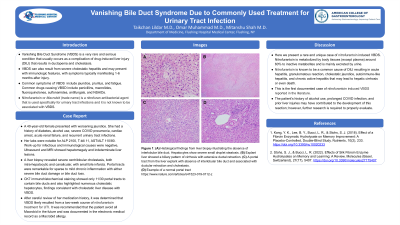Sunday Poster Session
Category: Biliary/Pancreas
P0085 - Vanishing Bile Duct Syndrome Due to Commonly Used Treatment for Urinary Tract Infection
Sunday, October 22, 2023
3:30 PM - 7:00 PM PT
Location: Exhibit Hall

Has Audio

Taikchan Lildar, MD
Flushing Hospital Medical Center
Flushing, NY
Presenting Author(s)
Taikchan Lildar, MD1, Omar Muhammad, MD2, Mitanshu Shah, MD1
1Flushing Hospital Medical Center, Flushing, NY; 2FHMC, Flushing, NY
Introduction: Vanishing Bile Duct Syndrome (VBDS) is a very rare and serious condition that usually occurs as a complication of drug-induced liver injury (DILI) resulting in ductopenia and cholestasis. VBDS can also result from severe cholestatic hepatitis and may present with immunologic features. Symptoms typically manifest 1-6 months after injury. Common symptoms include jaundice, pruritus and fatigue. Common drugs causing VBSD include penicillins, macrolides, fluoroquinolones, sulfonamides, antifungals, NSAID etc. Nitrofurantoin or Macrobid (trade name) is a class of antibacterial agent specific for urinary tract infections and is not known to be associated with VBDS.
Case Description/Methods: A 40-year-old female presented with worsening jaundice. She had a history of diabetes, alcohol use, severe COVID pneumonia, cardiac arrest, acute renal failure and recurrent UTI. Labs were notable for ALP 2100, T-bili 11, AST/ALT 110/80. Work-up for infectious and immunological causes were negative. Ultrasound and MRI showed hepatomegaly and indeterminate liver lesions. Liver biopsy showed severe centrilobular cholestasis, both intra-hepatocytic and canalicular, with small bile infarcts. Portal tracts were remarkable for sparse to mild chronic inflammation with either severe bile duct damage or bile duct loss. CK7 immunohistochemical stain showed only 11 out of 30 portal tracts to contain bile ducts and highlighted numerous cholestatic hepatocytes. The findings were consistent with cholestatic liver disease with VBDS. After careful review of patient medication history, it was determined that VBDS likely resulted from a two week course of nitrofurantoin treatment for UTI. It was recommended that the patient avoid all macrobid in the future and was documented in the medical record as a macrobid allergy.
Discussion: Here we present a rare and unique case of nitrofurantoin induced VBDS. Nitrofurantoin is metabolized by body tissues (except plasma) around 60% to inactive metabolites and mainly excreted by urine. Nitrofurantoin is known to be a common cause of DILI resulting in acute hepatitis, granulomatous reaction, cholestatic jaundice, autoimmune-like hepatitis and chronic active hepatitis that may lead to hepatic cirrhosis or even death. We report the first documented case of nitrofurantoin induced VBDS. The patient's history of alcohol use, prolonged COVID infection and prior liver injuries may have contributed to the development of this reaction; however, further research is required to properly evaluate.
Disclosures:
Taikchan Lildar, MD1, Omar Muhammad, MD2, Mitanshu Shah, MD1. P0085 - Vanishing Bile Duct Syndrome Due to Commonly Used Treatment for Urinary Tract Infection, ACG 2023 Annual Scientific Meeting Abstracts. Vancouver, BC, Canada: American College of Gastroenterology.
1Flushing Hospital Medical Center, Flushing, NY; 2FHMC, Flushing, NY
Introduction: Vanishing Bile Duct Syndrome (VBDS) is a very rare and serious condition that usually occurs as a complication of drug-induced liver injury (DILI) resulting in ductopenia and cholestasis. VBDS can also result from severe cholestatic hepatitis and may present with immunologic features. Symptoms typically manifest 1-6 months after injury. Common symptoms include jaundice, pruritus and fatigue. Common drugs causing VBSD include penicillins, macrolides, fluoroquinolones, sulfonamides, antifungals, NSAID etc. Nitrofurantoin or Macrobid (trade name) is a class of antibacterial agent specific for urinary tract infections and is not known to be associated with VBDS.
Case Description/Methods: A 40-year-old female presented with worsening jaundice. She had a history of diabetes, alcohol use, severe COVID pneumonia, cardiac arrest, acute renal failure and recurrent UTI. Labs were notable for ALP 2100, T-bili 11, AST/ALT 110/80. Work-up for infectious and immunological causes were negative. Ultrasound and MRI showed hepatomegaly and indeterminate liver lesions. Liver biopsy showed severe centrilobular cholestasis, both intra-hepatocytic and canalicular, with small bile infarcts. Portal tracts were remarkable for sparse to mild chronic inflammation with either severe bile duct damage or bile duct loss. CK7 immunohistochemical stain showed only 11 out of 30 portal tracts to contain bile ducts and highlighted numerous cholestatic hepatocytes. The findings were consistent with cholestatic liver disease with VBDS. After careful review of patient medication history, it was determined that VBDS likely resulted from a two week course of nitrofurantoin treatment for UTI. It was recommended that the patient avoid all macrobid in the future and was documented in the medical record as a macrobid allergy.
Discussion: Here we present a rare and unique case of nitrofurantoin induced VBDS. Nitrofurantoin is metabolized by body tissues (except plasma) around 60% to inactive metabolites and mainly excreted by urine. Nitrofurantoin is known to be a common cause of DILI resulting in acute hepatitis, granulomatous reaction, cholestatic jaundice, autoimmune-like hepatitis and chronic active hepatitis that may lead to hepatic cirrhosis or even death. We report the first documented case of nitrofurantoin induced VBDS. The patient's history of alcohol use, prolonged COVID infection and prior liver injuries may have contributed to the development of this reaction; however, further research is required to properly evaluate.
Disclosures:
Taikchan Lildar indicated no relevant financial relationships.
Omar Muhammad indicated no relevant financial relationships.
Mitanshu Shah indicated no relevant financial relationships.
Taikchan Lildar, MD1, Omar Muhammad, MD2, Mitanshu Shah, MD1. P0085 - Vanishing Bile Duct Syndrome Due to Commonly Used Treatment for Urinary Tract Infection, ACG 2023 Annual Scientific Meeting Abstracts. Vancouver, BC, Canada: American College of Gastroenterology.
